Understanding how cannabis naturally develops and completes its life cycle is fundamental to growing the best medicinal crop. Cannabis, whether cultivated indoors or out, has the same basic requirements for growth. It needs light, air, water, nutrients, a growing medium, and the proper environment to produce energy and to grow. Without any one of these essentials, growth stops and death soon results. Both indoors and outdoors, the light must be of the proper spectrum and intensity, and the air must be warm, arid, and rich in carbon dioxide. Water must be abundant but not excessive, and the growing medium must contain the proper levels of nutrients in an available form to sustain vigorous growth. When all these needs are in balance, cannabis plants will flourish on their own.
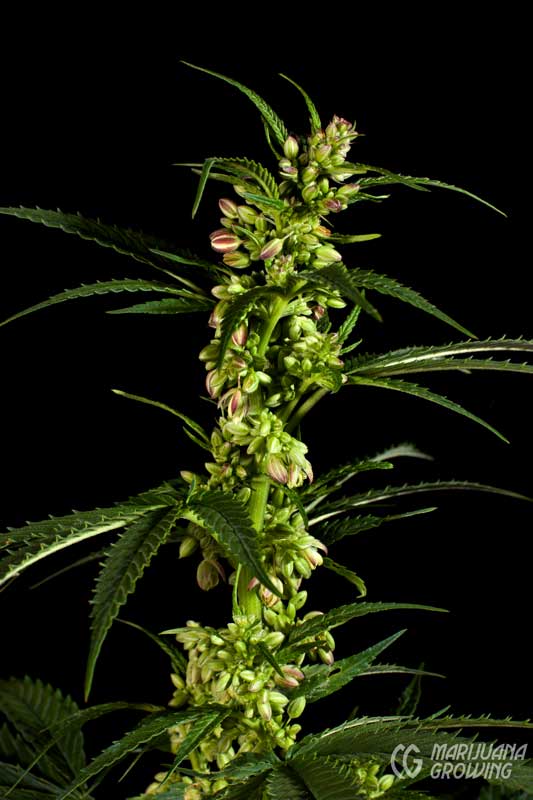
This male plant is laden with ripe male flowers that are packed with pollen. Cannabis is wind pollinated. Male plants release their pollen into the wind to pollinate nearby female plants. But pollen can also drift for several hundred miles when unobstructed. (MF)

This female, thin-leaved sativa is easily distinguished by the white fuzzy pairs of pistils protruding from each seed bract. The pistils catch male pollen that is ushered to fertilize the female ovary. (MF)
Innate Qualities of Cannabis
1. Cannabis is an annual plant, which means it completes its life cycle within one year or less.
2. Cannabis is dioecious, having both male and female plants. Mature female flowers contain more cannabinoids than males.
3. Cannabis sativa and Cannabis indica are “photoperiod determinate” plants; they require long nights to begin flowering. Flowering in Cannabis ruderalis is not triggered by the light cycle of long nights and short days. C. ruderalis flowers after 3–4 weeks of growth, regardless of the light schedule.
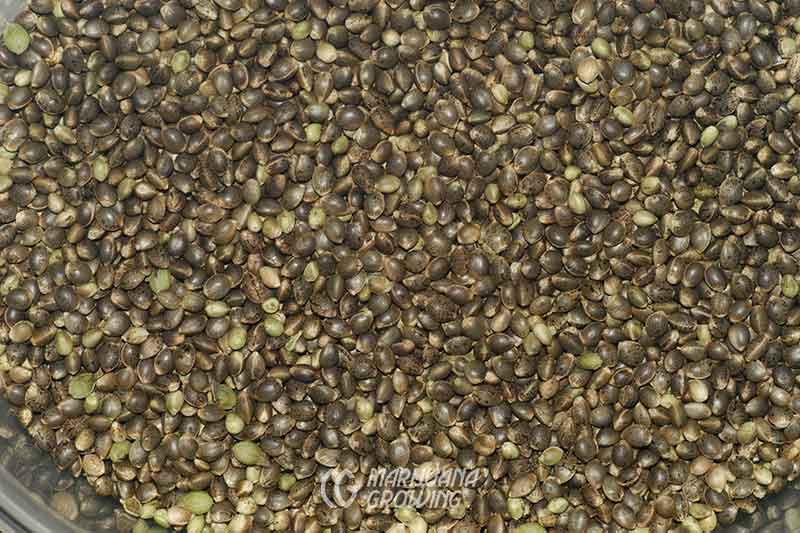
Seeds contain an exact genetic code to grow into strong, healthy cannabis plants with a rich cannabinoid profile. Seed selection is essential to produce a crop of cannabis with all the desired characteristics.
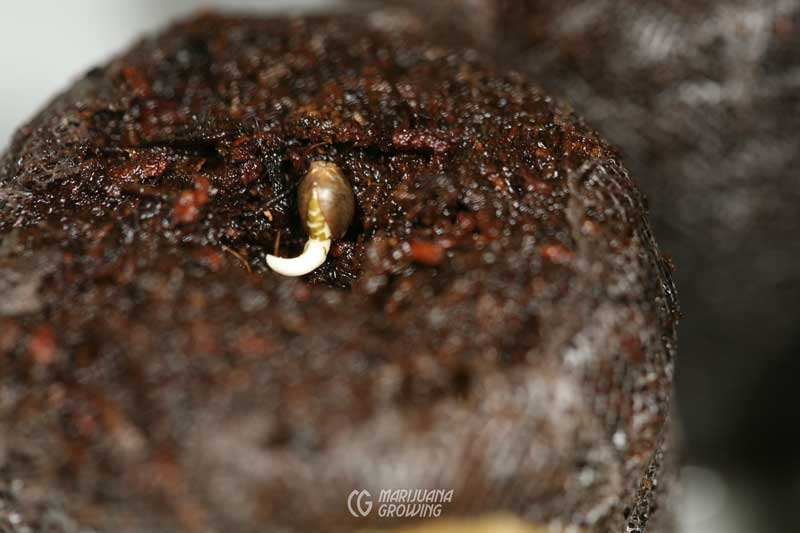
The seed has germinated and the little white rootlet is growing rapidly. Now is the time to plant this sprouted seed..
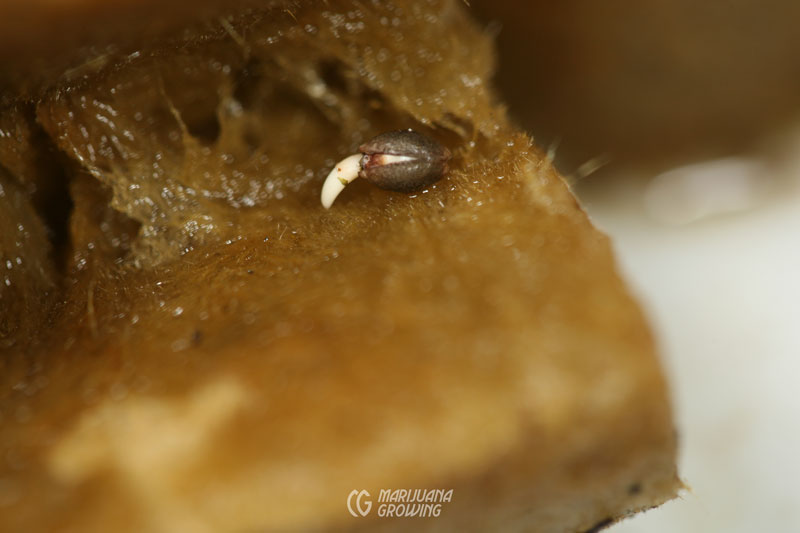
The initial white rootlet has just emerged from the seed.
Life Cycle of Cannabis
Cannabis is an annual plant; seeds planted in the spring will grow throughout the summer and flower in the fall. Cannabis typically is a dioecious species, meaning it has separate male and female plants. Plants with male flowers produce pollen, which is dispersed by the wind, and the female-flower-bearing plants will produce seeds when fertilized. The annual cycle starts all over again when the new generation of seeds sprouts the following year. In nature, cannabis goes through distinct growth stages: seedling, vegetative, pre-flower, and flower.
Seeds & Seedlings
Healthy seeds germinate 3 to 7 days after absorbing water from the medium, and transform into little sprouts. The seedling growth stage lasts about a month. During this first growth phase, seeds germinate, or sprout, establish a root system, grow a stem, and produce leaves to harvest sunlight and convert it into usable energy a process known as photosynthesis.
Germination
During germination, moisture, heat, and oxygen activate the embryo within the durable outer coating of the seed. The embryo expands, nourished by a supply of food stored within the seed. Soon, the seed’s coating splits, a white taproot grows downward, and a sprout’s cotyledons (seed leaves) push upward in search of light.
Seedling Growth
The primary root (taproot) grows downward due to gravity and branches out, similar to the way the stem branches up and out aboveground. These secondary branching roots are called lateral roots, and produce tiny rootlets that draw in water and inorganic salts the chemical nutrients required to sustain life. Roots also serve to anchor a plant in the growing medium and provide support for the growth above the soil. Seedlings should receive 16 to 24 hours of light to maintain vegetative growth. The seedling growth stage usually lasts 4–6 weeks, and most varieties will continue to vegetative growth as long as plants receive at least 16 hours of light every 24 hours.
Vegetative Growth
Cannabis will stay in the vegetative growth stage as long as it receives a minimum of 16 hours of light daily. As the plant grows above soil, its roots continue to fill the medium below the soil line. Cells in the root tips continue to divide and push farther and farther into the soil in search of more water and nutrients. Lateral root branches sprout, perpendicular to the primary roots, and then form thin root hairs that are also designed to harvest water and nutrients from the soil. If the soil dries out completely, these frail root hairs will desiccate and die. They are very delicate and are easily damaged or torn by klutzy hands if exposed or moved roughly. Extreme care must be exercised during transplanting. A strong, healthy root system is essential for optimum growth.
Like the roots, the terminal growth shoot at the top of the plant also has cells that divide and multiply at its tip, called the meristem. These cells give rise to new auxiliary buds, which themselves become lateral leaves and shoots. The central, or apical, bud carries growth upward; side, or lateral, buds turn into branches or leaves. The vascular system, located within the main stem, transmits water and nutrients from the root system to the growing buds, leaves, and flowers where sugars are produced via photosynthesis and are then redistributed throughout the plant. This fluid flow takes place in specialized tissues called xylem and phloem; xylem bring nutrients and water to the sites of photosynthesis in the leaves, and phloem brings the resulting sugars to parts of the plant that do not undergo photosynthesis.
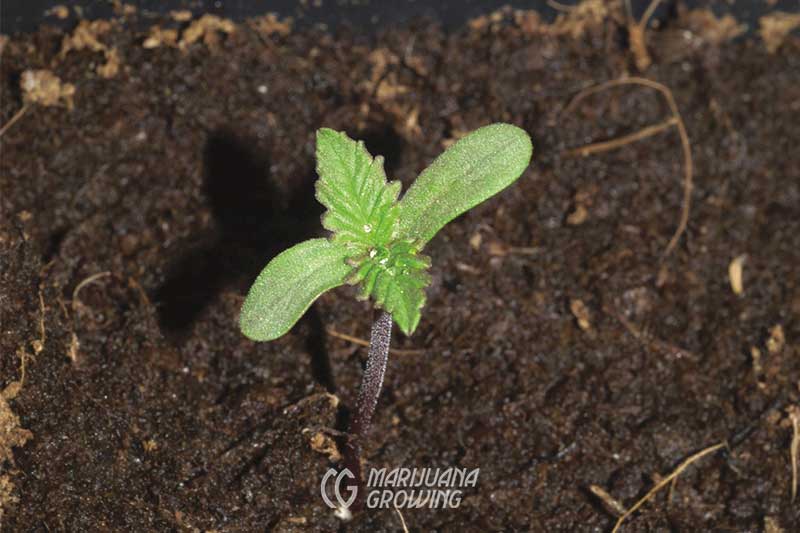
In a week to 10 days, a small seedling will break through the soil. The first rounded seed leaves give way to the first set of “true leaves” having the classic serrated edges.
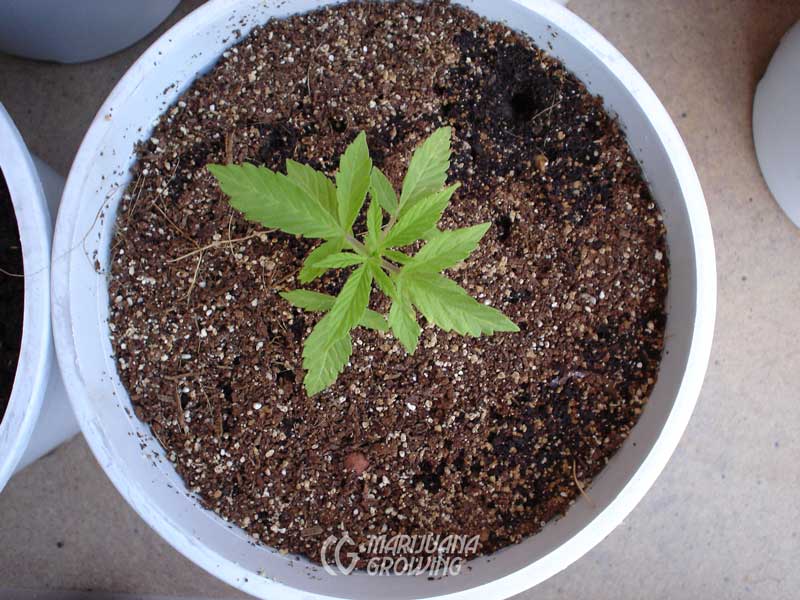
The tender little seedling continues to grow. Leaves multiply, stem girth increases, and the tip continues upward toward the light.
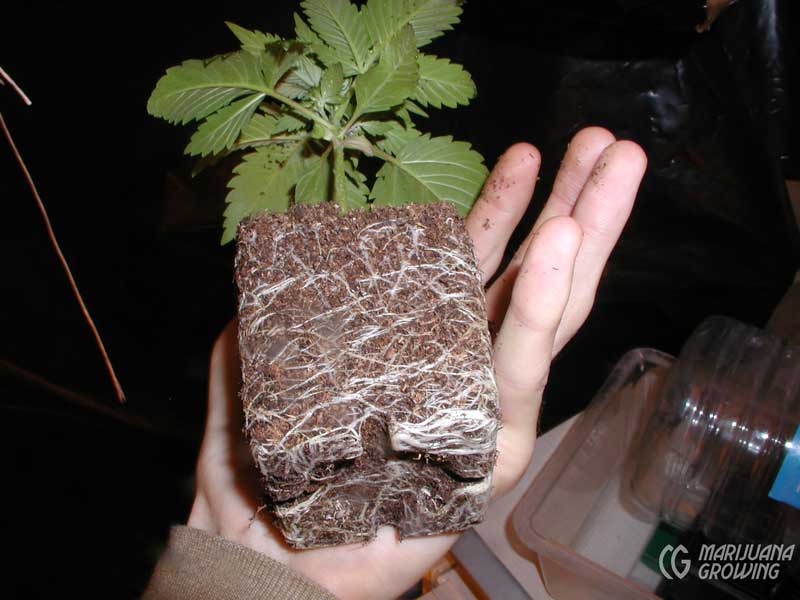
In a few weeks seedlings have established root systems and have started the vegetative growth stage. Plants soon outgrow containers and must be transplanted.
The stem also supports the plant with cellulose and lignin located within cell walls and structures along the stem. Outdoors, rain and wind push plants around, causing microtears in these tissues, which are repaired by the deposition of cellulose and lignin. These tissues together provide strength and make the stem strong and rigid. Indoors and in greenhouses, with no natural wind or rain present, cellulose and lignin production is often lower, so plants develop weak stems and may need to be staked up later, especially during flowering. To help build strong stems, make sure to have adequate air movement in the grow-room or greenhouse environment.
Once green tissues are present in the seedling, the plant starts to manufacture food (carbohydrates) and produce energy from the sunlight and nutrients in the soil. This process is known as photosynthesis. Chlorophyll is the substance that gives plants their green color, and it is found in cellular structures called chloroplasts. Inside chloroplasts is where light energy, carbon dioxide (CO2) taken from the air, and water and nutrients from the soil are converted into carbohydrates and oxygen. This process releases usable energy and creates starches or sugars that are later used in the production of plant tissues and cellular components.
Tiny breathing pores called stomata are located on the underside of the leaf. Stomata are the entry point of CO2 into the plant, where it is then used in photosynthesis. The stomata open and close to regulate the flow of moisture and oxygen from the leaf—both of which are waste products of photosynthesis. The stomata are very important to the plant’s overall health and function.
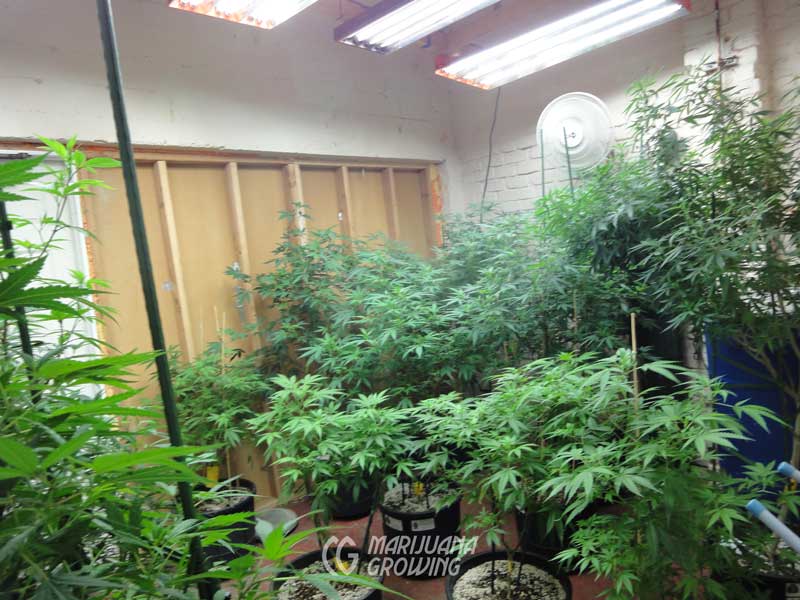
This indoor vegetative garden room is illuminated 18 hours a day, with 6 hours of darkness. This light regimen keeps plants in the vegetative growth cycle.
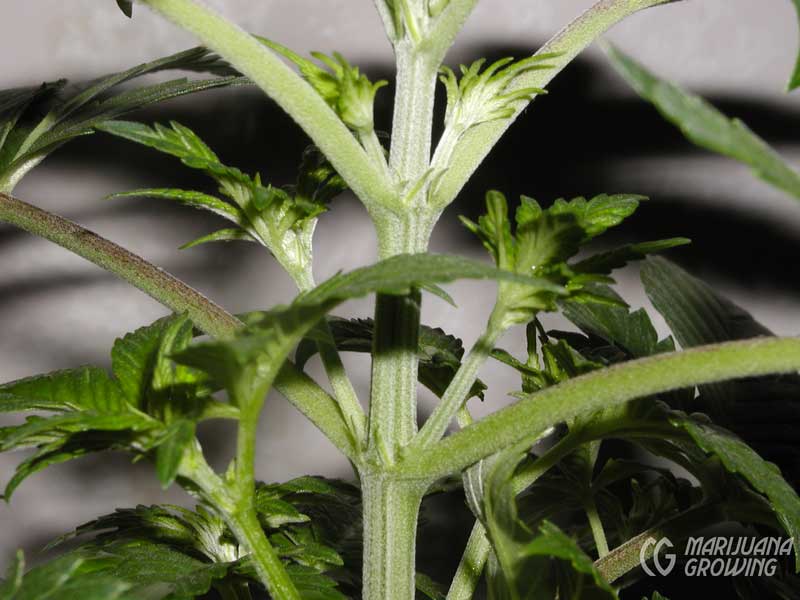
Stems must be stout to support heavy flower buds. The internodes on this plant’s stems are growing close together. This is a desirable trait when cultivating indoors.
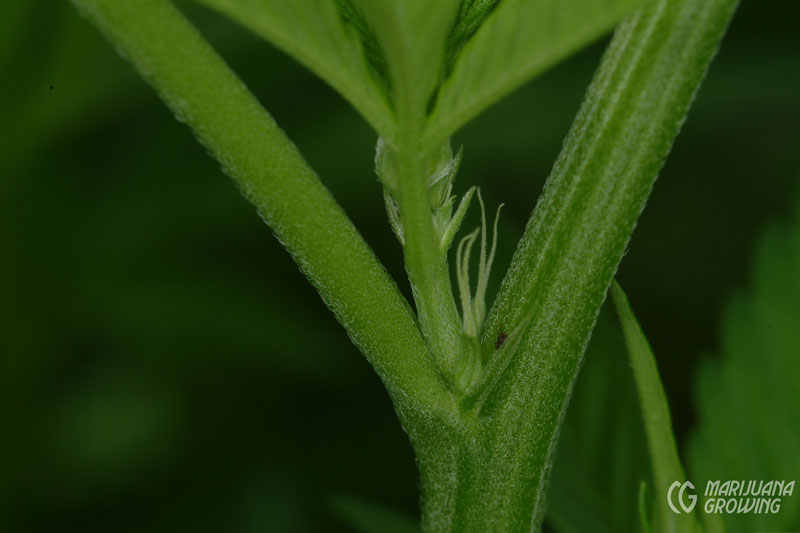
This female pre-flower appears about 4 to 5 branches down from the top of the plant, about 2 months after the seed sprouts. The white fuzzy hairs (female stigmas) show that this plant has designated sex and is a female.
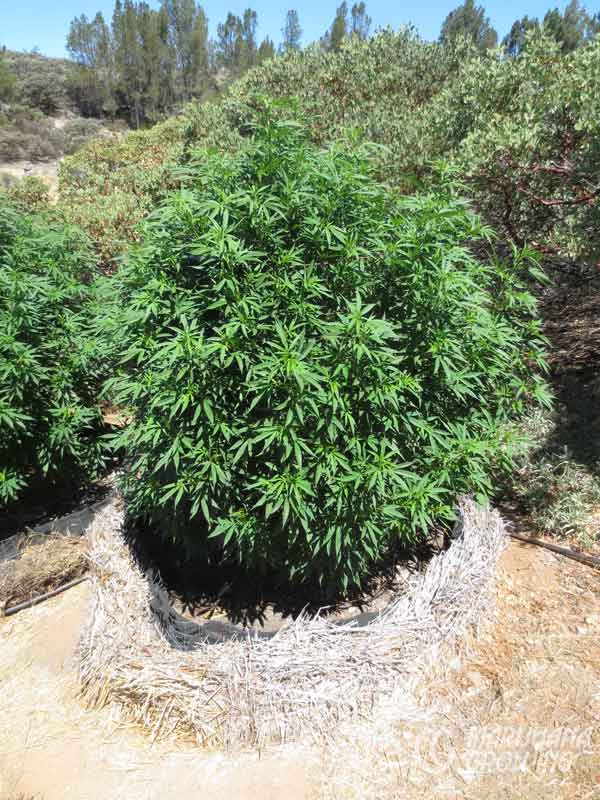
Vegetative growth outdoors is often much more profuse than indoors. It is difficult for artificial light and an artificial growing environment to compete with natural sunlight and Mother Nature.
Pre-flowering
Cannabis grown from seed typically begins to show early development of floral bud structures commonly known as pre-flowers. The vast majority of varieties begin to produce these immature sexual organs by the fourth or fifth week of vegetative growth. In some varietals, pre-flowers can be seen as early as the fourth node; however they generally appear between the fourth and sixth node from the bottom of the plant. Cannabis plants are normally either all male or all female, with each sex having its own distinct form of pre-flower. Use pre-flowers to identify the gender of the plants and separate the females for flower production. Female flowers are cultivated for their high cannabinoid content, and are therefore prized. Male plants have lower levels of cannabinoids (THC, CBD, CBN, etc.) and are not typically kept by cannabis cultivators. Male plants are normally removed and destroyed by growers, but can also be maintained and evaluated as potential breeding stock.
Indoor plants grown from seed are most often left in the vegetative growth stage for 4 to 6 weeks, or until they are a minimum of 12 to 18 inches (30–45 cm) tall, before being induced to flower. Smaller plants can be induced to flower, but this practice is typically not recommended for plants grown from seed and is more practical for crops grown from clones. Premature flowering of young plants from seed can cause sexual instability (intersex expression) in some varieties.
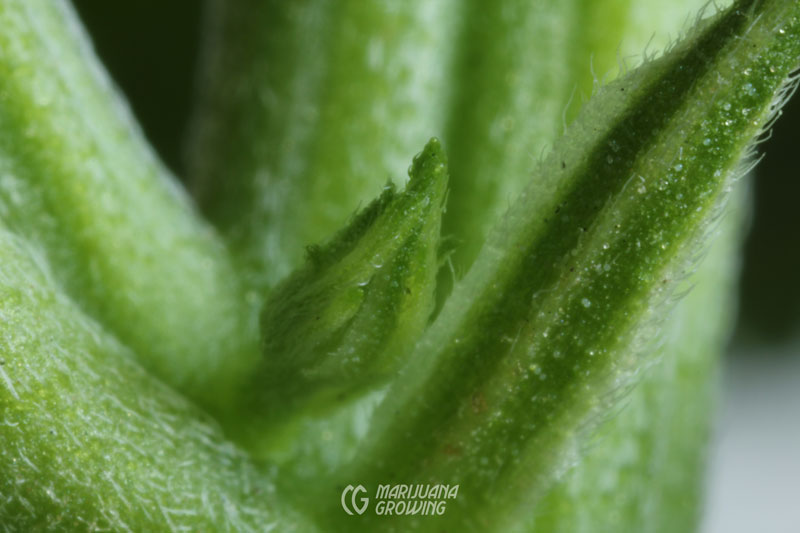
A tiny male pre-flower appears near the end of the natural vegetative growth cycle. The little shoot has all the characteristics of a male flower and will continue to grow and then manufacture and release male pollen. (MF)
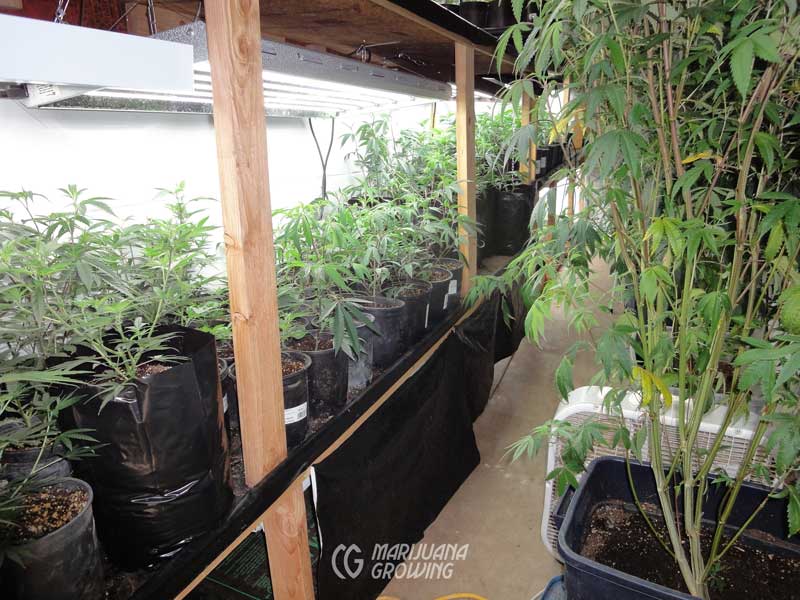
Mother plants are growing on the right in this garden; rooted clones in the vegetative growth stage are growing under T5 fluorescent lights on the left.
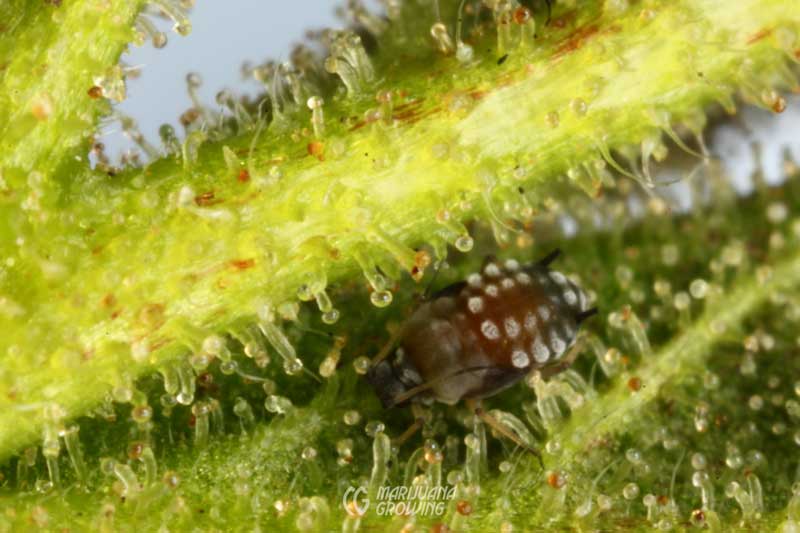
Insects and mites can become a big problem, especially on indoor and greenhouse crops. This aphid has found a new way to disguise itself. The translucent spots on its back look very similar to cannabis resin! (MF)
Flowering
Cannabis enters the flowering stage in the late-summer and early fall. As the nights become longer and days shorter, plants are signaled that their annual life cycle is beginning to come to an end, and the flowering stage begins. C. sativa and indica are photoperiod-determinate plants requiring longer nights and shorter days to induce flowering. C. ruderalis is not induced to flower by changes in light cycle and starts flowering when the plants reach 3 or 4 weeks of age, regardless of the light regimen.
Left unpollinated, female flowers develop without seeds, commonly known as “sinsemilla” from the Spanish sin semilla, or literally “without seed.” Unfertilized female plants continue to produce flowers and become increasingly covered in resinous, glandular trichomes, which produce the essential oils that give cannabis its unique smells (terpenes), in addition to the medicinal compounds known as cannabinoids. Trichomes produce numerous plant secondary metabolites, and recent studies show that some of the molecules produced in cannabis trichomes belong to families of compounds with proven antifungal, antimicrobial, and antibiotic properties. Genes that provide resistance to dehydration are also present, and in many species trichomes are known to inhibit insect movement. All of these factors support the hypothesized role of trichomes and their by-products providing protection from insects, fungi, UV light, and so forth, that might damage the developing seed within the female flower during gestation.
After weeks of heavy flower production, cannabinoid content and other secondary metabolite production peaks in the unfertilized sinsemilla flowers. This is the ideal moment for harvest; no new flowers are being produced, and the unseeded floral clusters are at their maximum coverage of glandular trichomes rich in cannabinoids and other essential oils.
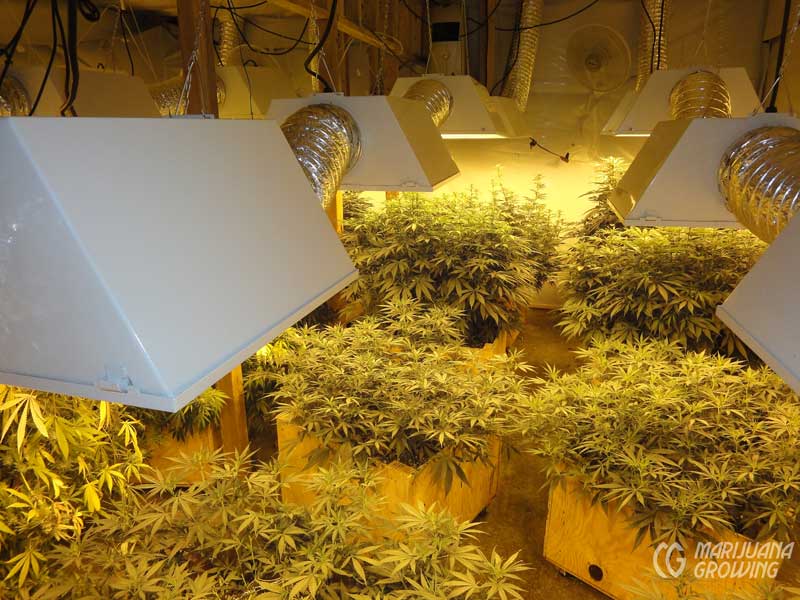
Small indoor plants typically yield from 1 to 4 ounces (30–120 gm). Outdoors and in greenhouses, cannabis is able to stay in the vegetative growth stage for several months and reach final heights of from 5 to 25 feet (1.5–8 m). Given an ideal environment, the longer vegetative period allows single plants to produce 5 to 10 pounds (2–5 kg) of cannabinoid-rich dried flowers.
Male plants produce pollen, which is released into the wind and by chance lands upon the stigma of a nearby unpollinated female flower. The flower becomes fertilized, and the seed that will form the next generation begins to grow under the protective layer of trichomes found on the female bract. After shedding all the pollen from the staminate flower, male plants senesce and eventually die. The seeds in the female plant continue to mature for 3 to 6 weeks after fertilization. Once ripe, the seeds will split through the protective bract, and the female plant will also begin to senesce, leaving the seeds to fall to the ground.
Indoors, flowering can be induced in most commercial varieties of cannabis by providing 12 hours of uninterrupted darkness and 12 hours of light every 24 hours. Plants that developed in tropical regions often start flowering when given 12-hour days and nights, but flowering can continue for up to 20 weeks. Some growers who cultivate equatorial sativa varieties will increase the period of darkness to 13 hours and beyond, in an attempt to mimic the natural light cycle in the tropics.
Plant growth structure changes during flowering. New shoot and leaf growth slows and flowers begin to form. Cannabis has both male and female plants. When both male and female flowers are in bloom, male flowers release pollen into the air that lands on female flowers, thereby fertilizing them. The male dies after producing and shedding all its pollen. Seeds form and grow within the female flowers. As the seeds are maturing, the female plant slowly senesces and dies. The mature seeds then fall to the ground and germinate naturally or are collected for planting next spring.
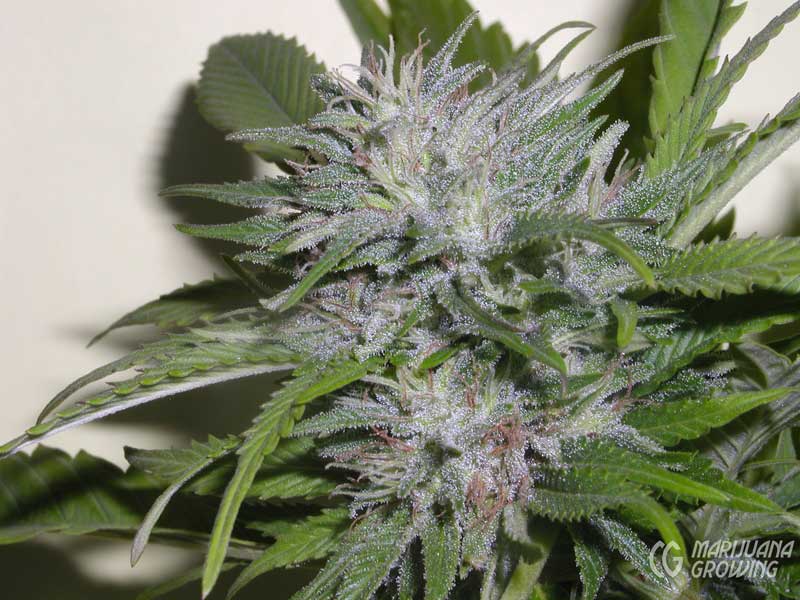
This cannabis flower appears to be frosted with cannabinoid-rich resin and will be ready to harvest in a couple of days. The cannabis varieties available today make growing a potent medical cannabis crop easy.

Some varieties such as ‘Power Plant’ produce big central buds very quickly.
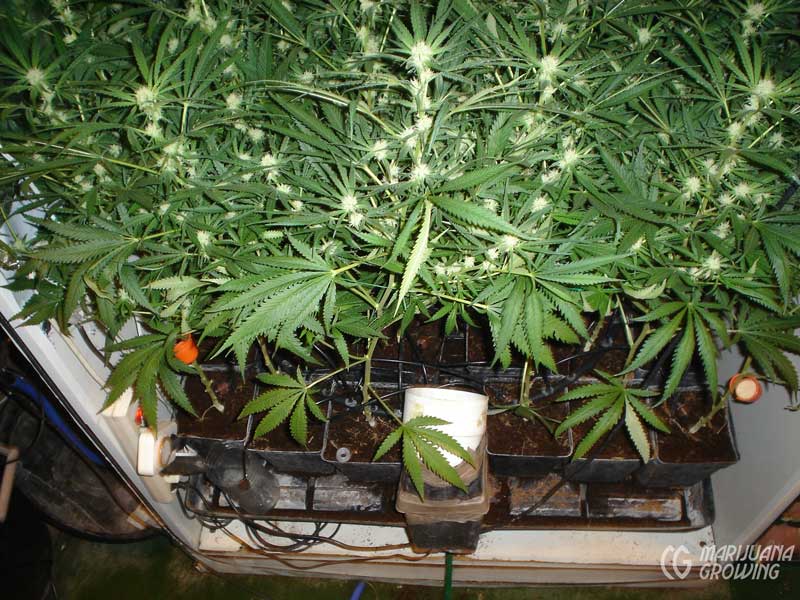
This garden has been flowering for 4 weeks. Small indoor gardens like this 40-inch-square (1 m2) garden are easy to set up. Note that this garden is being watered automatically and requires little maintenance.
Mother Plants
Vigorous, healthy female plants known to produce high-quality flowers with desirable cannabinoid profiles make the best mother plants, although any plant deemed desirable can be made into a mother, or donor, plant. Mother plants are given 18 to 24 hours of light daily to ensure they stay in the vegetative growth stage. For vegetative reproduction, stem cuttings of shoots or branches are cut from mother plants and placed in a growth medium to establish roots. The rooted stem cuttings are often called “clones,” since the new plants share the exact genetic code of the mother plant and thus will grow identically when given the same environment. Cultivating several vigorous, healthy, insect-free mother plants is the key to having a consistent supply of all-female clones.
A single mother plant can supply a garden with hundreds of clones in a few short months. Indoors clones can be induced to flower as early as 6 to 12 inches (15–30 cm) tall, or can be grown until 3 feet (90 cm) or taller before being induced to flower. The identical “clones” are moved into the flowering room as soon as the previous crop is harvested. Outdoor gardeners grow clones indoors until they are about 2 feet tall (60 cm) before moving them outdoors or to a greenhouse for planting.
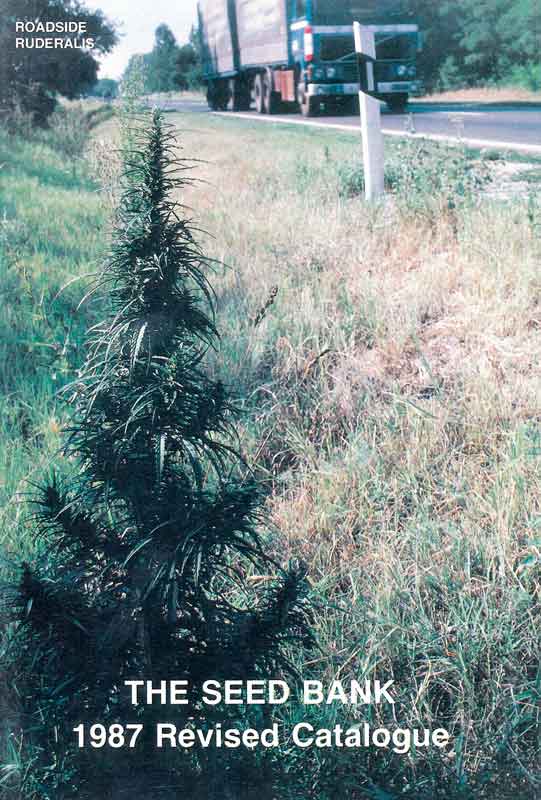
This C. ruderalis plant was growing along the highway in Hungary in the mid-1980s, when Nevil, founder of the Seed Bank, snapped this photo. Breeders have been working with daylight-neutral ruderalis genetics for many decades. In the last few years ruderalis varieties have been crossed with “regular” varieties that impart a strong cannabinoid profile and harvest weight.
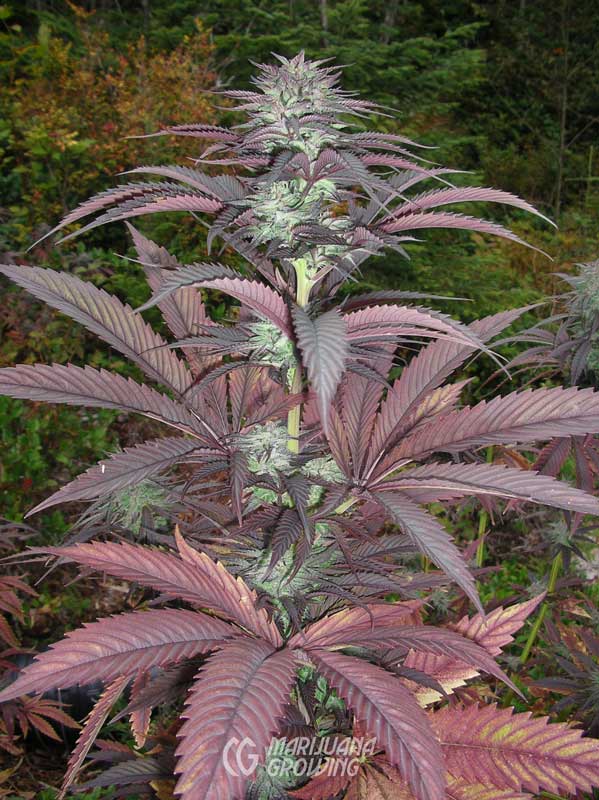
Genetics and temperature play a big role in purple-colored leaves. Some plants like this ‘Purple Pineberry’ are predisposed to turning color. When grown in cool weather the colors are more pronounced.
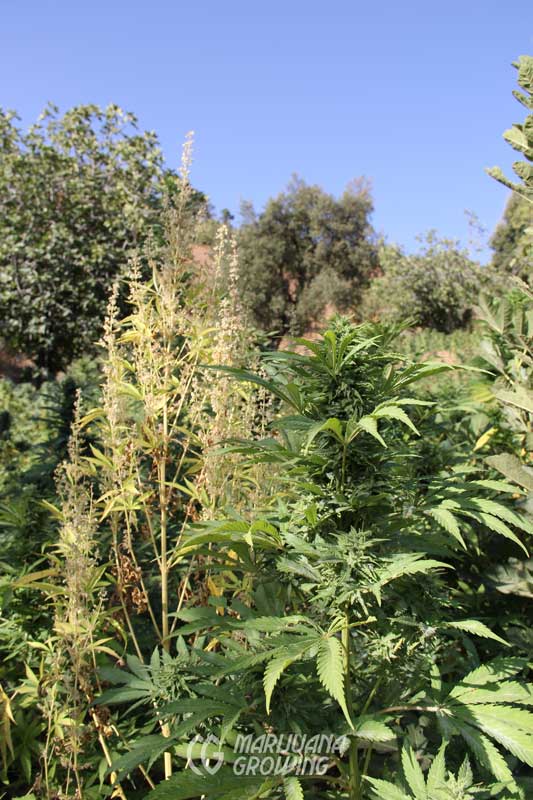
Male plants are normally removed from the garden so that they do not pollinate female plants. The male plant on the left is in full flower and spreading its pollen to all the female plants. Females will grow ripe seeds in 6 to 8 weeks.
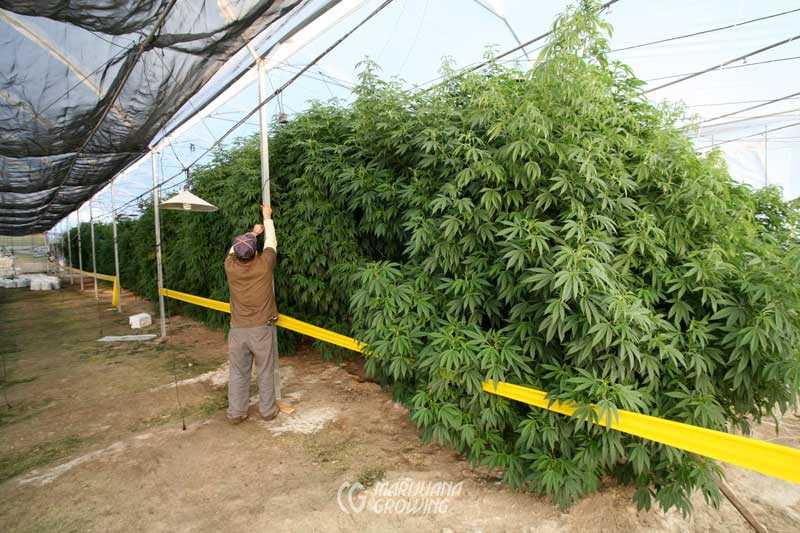
Mother plants can be maintained and grown for many months. These mother plants on a Mexican farm have been in the ground for almost a year!
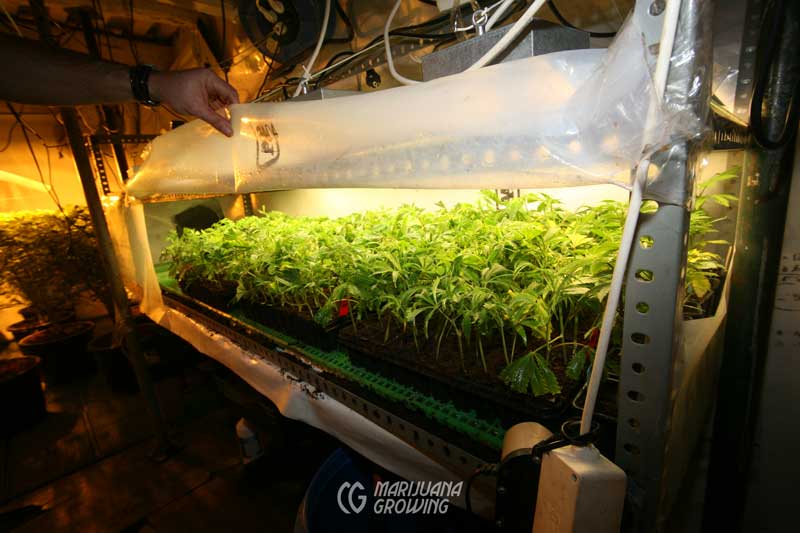
Once cut, clones are rooted under fluorescent light for about two weeks, until they develop a root system.
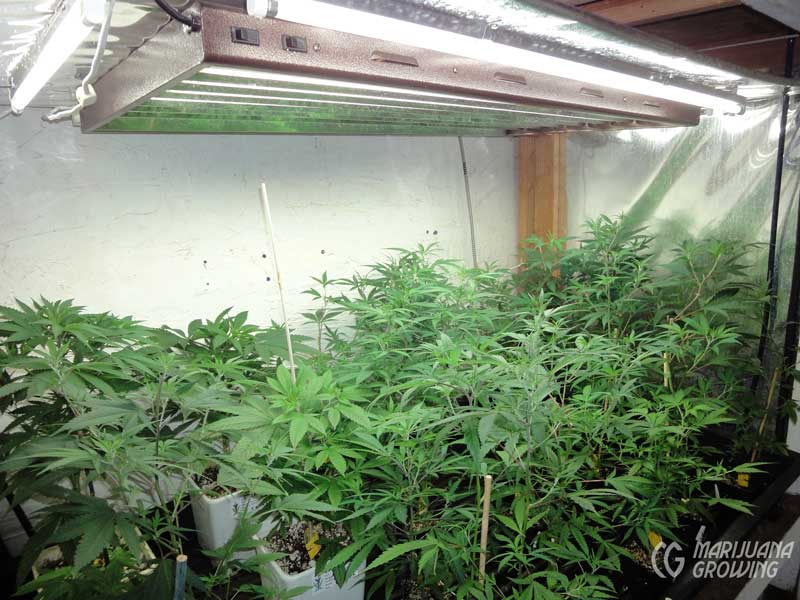
This indoor garden is growing under T5 fluorescent lights. The T5s are able to supply plenty of light for vegetative growth. The plants are in individual containers and are easy to move in the garden.
Clones
Branch tips are cut and rooted in a new medium to form stem cuttings or clones.
Clones take 10–20 days to grow a strong, healthy root system, but can begin to show roots in as short as 6 days. Clones are given 18–24 hours of light so they stay in the vegetative growth stage, and once the root system is established, clones are transplanted into larger containers. Indoors, clones grow for an additional 1–4 weeks or more in the vegetative growth stage before being induced to flower. Outdoors, clones are transplanted into large containers or Mother Earth, and they stay in the vegetative growth stage until nights grow long in the late summer, which induces them to flower.
Three Gardens
This section outlines 3 different gardens in 3 different locations: indoor, greenhouse, and outdoor. The examples show different planting and harvesting scenarios that use the natural advantages provided by each garden and the varieties grown. For more complete information about each type of garden, see chapters on Garden Rooms, Case Studies, Outdoors, and Medical Cannabis Varieties.
Indoor Gardens
Maintain mother plants and clones 18 to 24 hours of light daily. Induce vegetative plants to flower by providing 12 hours of uninterrupted darkness and 12 hours of light every 24 hours. Once the dark/light schedule has been set to 12 hours dark and 12 hours light, most varieties of cannabis will flower and can be harvested in 60 to 90 days.
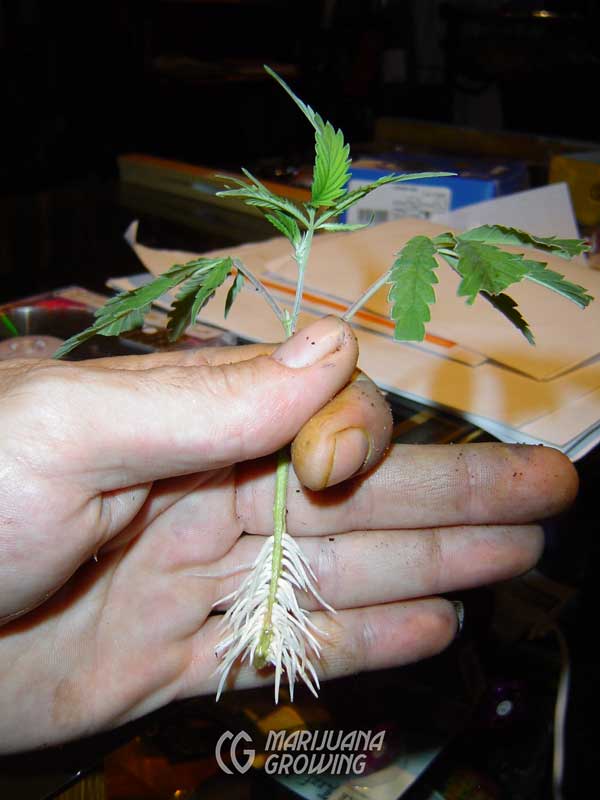
Branch tips are cut and rooted in rockwool cubes or other growing mediums. The cuttings grow roots in about 2 weeks and are then ready to plant.

Black plastic is alongside this light deprivation greenhouse. Every day the black plastic is pulled over the greenhouse to black it out and create a total of 12 hours’ darkness, which induces flowering in indica and sativa varieties of cannabis.
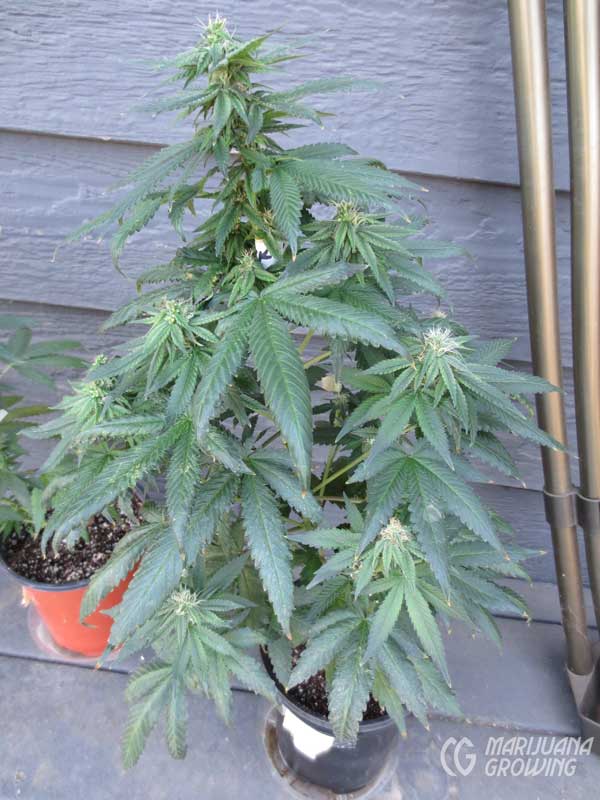
This autoflowering feminized seedling is an example of how a germinated seed can grow into a mature plant ready for harvest in just 70 days and receive 18 hours of daily light!
First Harvest
Indoor Spring Crop – 90 days
January 1 – Move well-rooted 12- to 18-inch-tall (30–45 cm) female clones into room under 18 to 24 hours of light.
January 21 – Transplant clones into 3-gallon (11 L) containers.
January 30 – Induce flowering with 12-hour days and nights.
February 7 – Take cuttings and start the next crop of clones. Give clones 18 to 24 hours of light.
March 30 – Harvest first crop.
Second Harvest
Indoor Summer Crop – 90 days
April 1 – Move well-rooted female clones into room under 18 to 24 hours of light.
April 21 – Transplant clones into 3-gallon (11 L) containers.
April 30 – Induce flowering with 12-hour days and nights.
May 7 – Take cuttings and start the next crop of clones. Give clones 18 to 24 hours of light.
June 30 – Harvest first crop.
Third Harvest
Indoor Autumn Crop – 90 days
July 1 – Move well-rooted female clones into room under 18 to 24 hours of light.
July 21 – Transplant clones into 3-gallon (11 L) containers.
July 30 – Induce flowering with 12-hour days and nights.
August 7 – Take cuttings and start the next crop of clones. Give clones 18 to 24 hours of light.
September 30 – Harvest first crop.
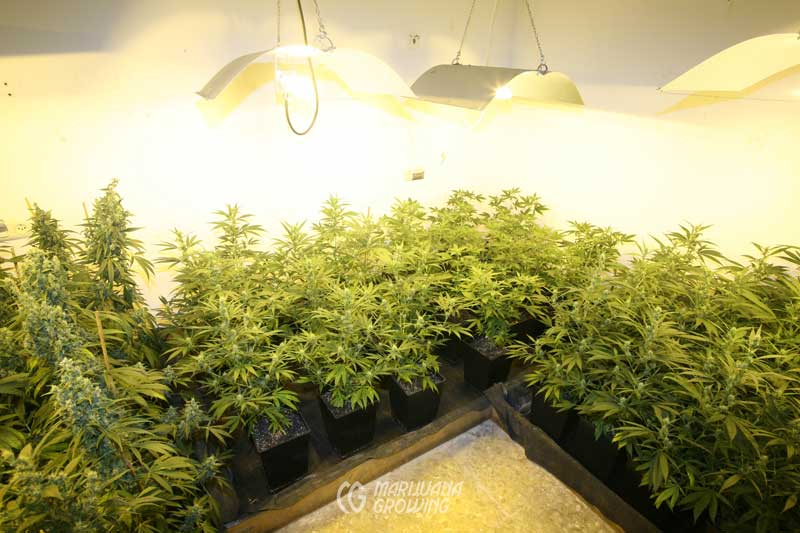
The garden on the right is about a week ahead of the garden on the left and will be harvested a week earlier.
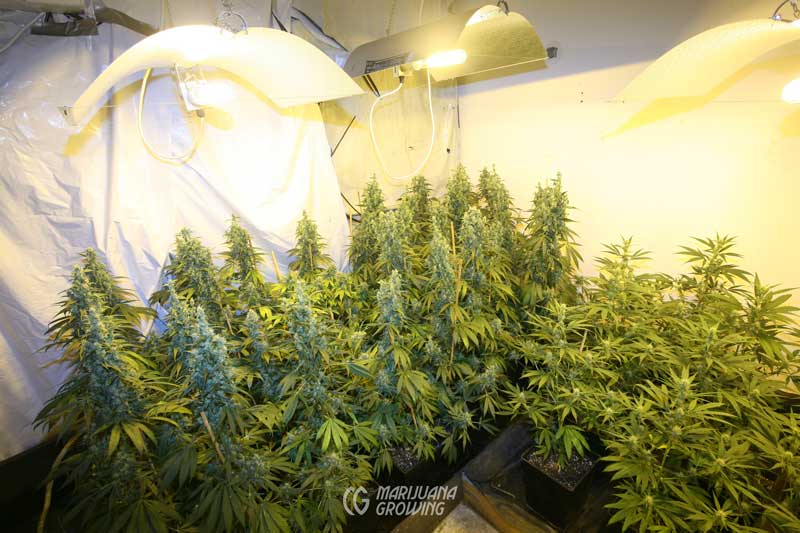
The plants on the left will be ready to harvest in about a week. The plants on the right are about 2 weeks into flowering and will be harvested in about 6 weeks.
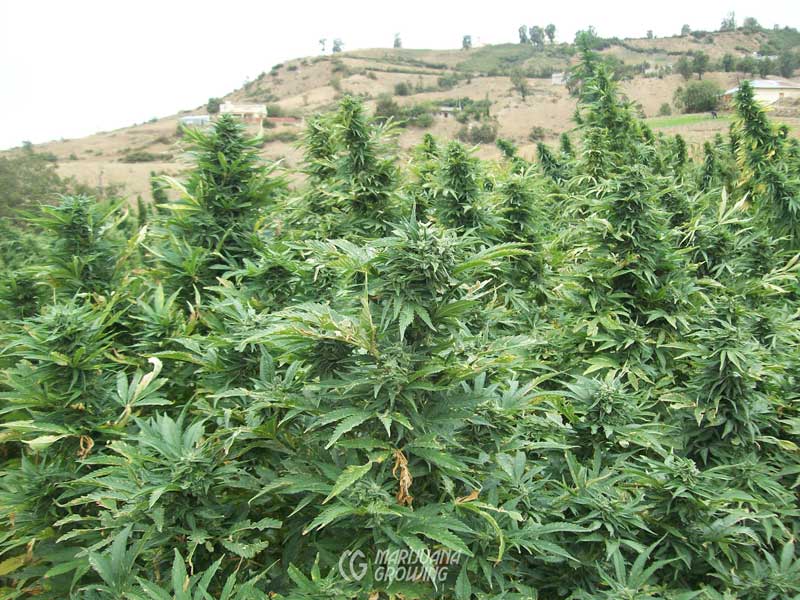
Plant a spring crop in warm climates. Diminished sunlight intensity produces smaller buds, about half to three-quarters as big as others. If plants get cold at night, growth slows.
Greenhouse Gardens
Greenhouse crops can be harvested 2 or more times a year, but most often greenhouses are planted in the spring and yield a single harvest in the fall. In cold climates, greenhouses must be heated. All greenhouses must be vented or cooled in warm weather. The basic harvest scenario below shows how to harvest 3 greenhouse crops every year.
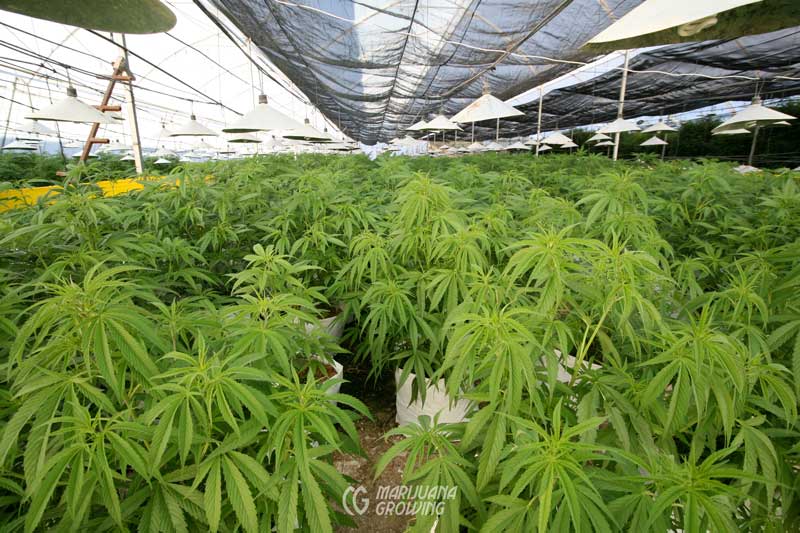
This Mexican greenhouse needs shade cloth and supplemental lighting at night to keep plants in the flowering growth stage. The days and nights are between 11 and 13 hours long all year round. This is the perfect photoperiod for flowering in cannabis.
First Harvest
Greenhouse Spring Crop – 90 days
March 1 – Move bushy, well-rooted 1- to 2-foot-tall (30–60 cm) clones and seedlings into greenhouse.
March 1 – Long 12-hour nights and short 12-hour days in spring signal cannabis to flower.
March 15 – Remove any male plants. To distinguish plants, look for male pre-flowers.
March 15 – Transplant clones and female seedlings into large containers.
April 15 – Darken greenhouse after 12 hours of daylight, until harvest.
May 30 – Harvest: The less-intense sunlight will make for smaller buds than harvests later in the season.
Second Harvest
Greenhouse Summer Crop – 90 days
June 1 – Move bushy, well-rooted 1- to 2-foot-tall (30–60 cm) clones and seedlings into greenhouse.
June 15 – Remove male plants; male pre-flowers distinguish male plants from females.
June 15 – Transplant clones and seedlings into larger containers.
July 1 – Induce flowering by blacking out (covering) greenhouse after 12 hours of light.
July 15 –Verify the gender of all plants. Remove any remaining males.
August 1 – Maintain flowering by covering greenhouse after 12 hours of light until harvest.
August 30 – Harvest a heavy crop of top-quality medical cannabis flower buds that have received maximum levels of sunlight.
Third Harvest
Greenhouse Autumn Crop – 75 days
September 1 – Move bushy, well-rooted 1- to 2-foot-tall (30–60 cm) clones and seedlings into greenhouse.
September 15 – Long nights and short days of autumn signal cannabis to start flowering.
October 15 – Medical cannabis flowers develop but low light levels limit growth.
November 15 – Harvest smaller buds that have received less-intense fall sunlight.
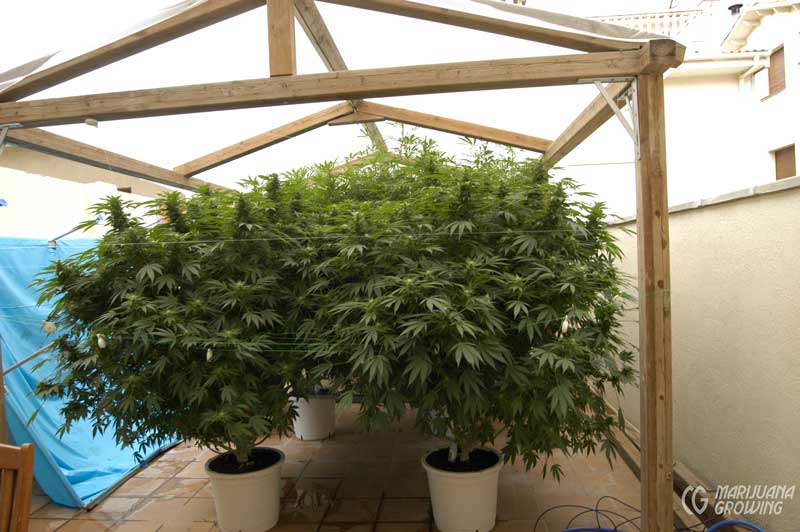
This small greenhouse protects flowering cannabis from regular rains and bad weather. It also keeps plants a little warmer at night. More regular irrigation is necessary when growing large plants in small containers.
Outdoor Gardens
Typically, outdoor gardens are planted in the spring and harvested in autumn. By applying information from this chapter, outdoor gardens can be harvested 2 or 3 times a year within moderate to temperate climates. Transplanting clones and seedlings and harvesting a single crop is all that is possible in cold climates with a growing season of 90 days. Extra care must also be taken to protect seedlings and clones from harsh weather.
First Harvest
Mild Climate Spring Crop – 90 days.
March 1 – Move bushy, well-rooted 1- to 2-foot tall clones and seedlings into a full-sun-heated greenhouse.
March 1 – Long nights will induce cannabis to flower.
March 15 – Remove male plants; male flowers distinguish male plants.
March 15 – Transplant clones and female seedlings into large containers.
March 15 – Move outdoors in mild climates – may need to cover on cool nights.
April 15 – Darken plants after 12 hours of daylight if flowering slows..
May 30 – Harvest smaller buds that received less-intense spring sunlight.
Second Harvest
Mid-summer Crop – 70–75 days
May 1 – Start ruderalis-dominant (super-autoflowering feminized) variety indoors.
May 15 – Transplant autoflowering feminized variety to 3-gallon (11.3 L) containers
May 21– Transplant strong, healthy plants to outdoor garden.
June 1 – Female flowers are visible.
1July 15 – Harvest 3 to 3.5 ounces (85–100 gm) of dried flower buds per plant.
Third Harvest
Pure Indica/Sativa and Indica/Sativa Crosses
March 1 – Plant clones and seedlings indoors.
May 1 – Move bushy 1- to 2-foot-tall clones and seedlings outdoors in temperate climates.
May 1 – Pre-flowers appear; remove male plants.
June 1 – Move bushy 1- to 2-foot-tall clones and seedlings outdoors in all climates.
August 1 – Flowers start to form; remove any “surprise” male plants.
September – Harvest a large crop from big plants.
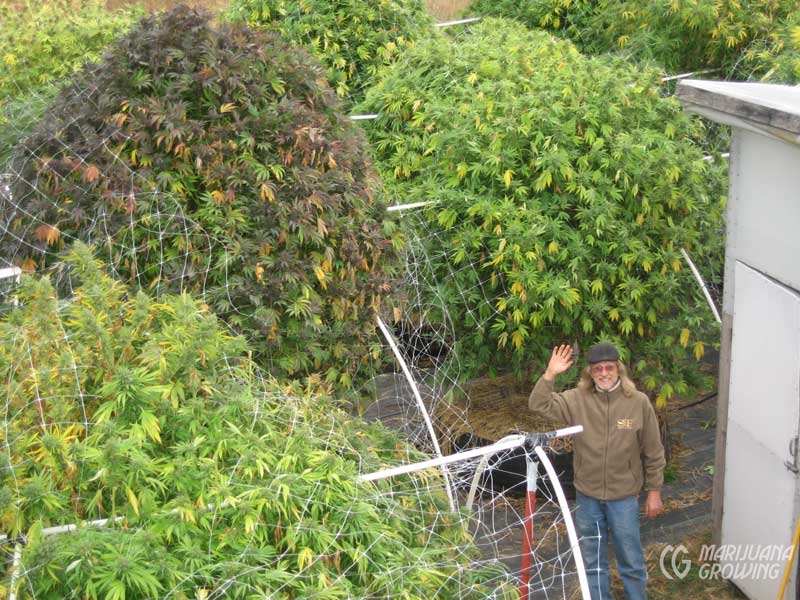
Spring-planted autumn crop – 210 days. A complete 7-month-long season will yield very big plants when grown properly. These 10-pound (4.5 kg) plants received full sun all day long and grew in outstanding organic soil.

